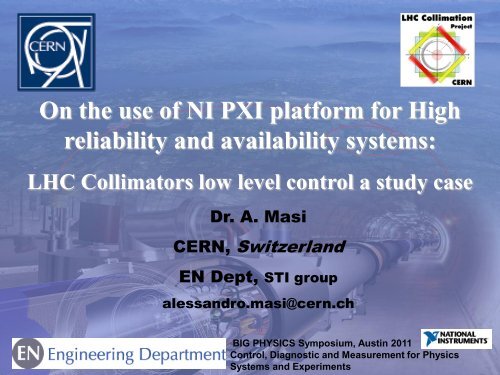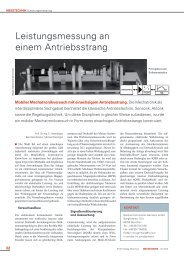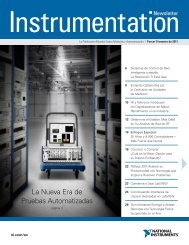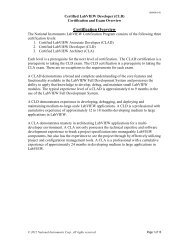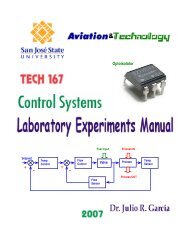On the use of NI PXI platform for High reliability and availability ...
On the use of NI PXI platform for High reliability and availability ...
On the use of NI PXI platform for High reliability and availability ...
Create successful ePaper yourself
Turn your PDF publications into a flip-book with our unique Google optimized e-Paper software.
<strong>On</strong> <strong>the</strong> <strong>use</strong> <strong>of</strong> <strong>NI</strong> <strong>PXI</strong> <strong>plat<strong>for</strong>m</strong> <strong>for</strong> <strong>High</strong><br />
<strong>reliability</strong> <strong>and</strong> <strong>availability</strong> systems:<br />
LHC Collimators low level control a study case<br />
Dr. A. Masi<br />
CERN, Switzerl<strong>and</strong><br />
EN Dept, STI group<br />
aless<strong>and</strong>ro.masi@cern.ch<br />
BIG PHYSICS Symposium, Austin 2011<br />
Control, Diagnostic <strong>and</strong> Measurement <strong>for</strong> Physics<br />
Systems <strong>and</strong> Experiments
Outline<br />
• The LHC collimation system<br />
• Reliability <strong>and</strong> Availability Requirements<br />
• The control architecture<br />
• Reliability <strong>and</strong> <strong>availability</strong> review<br />
• Lessons learnt by <strong>the</strong> 2010 operation<br />
• Are <strong>NI</strong> <strong>PXI</strong> systems suitable c<strong>and</strong>idates<br />
<strong>for</strong> high <strong>reliability</strong> <strong>and</strong> <strong>availability</strong> control<br />
systems ???<br />
• Conclusions
• The LHC collimation<br />
system<br />
• The control<br />
architecture<br />
• R&A review<br />
• Lesson learnt by<br />
2010 operation<br />
• <strong>NI</strong> <strong>PXI</strong> <strong>plat<strong>for</strong>m</strong>s<br />
suitable <strong>for</strong> high R&A<br />
systems<br />
• Conclusions<br />
The collimation system must carry out 2 main functions:<br />
1. Beam cleaning, i.e. removing stray particles which<br />
may induce quenches in SC components. 2 out <strong>of</strong><br />
100k particles enough to trigger quench …<br />
Several types <strong>of</strong> collimators at multiple locations are required to ensure<br />
efficient beam cleaning ...<br />
Very complex system (100+ LHC Collimators)<br />
Total <strong>of</strong> 108<br />
Secondary<br />
Tertiary<br />
collimators<br />
Collimator<br />
Collimator<br />
(TCS) (100 movable). (W)<br />
Two jaws (4 motors)<br />
per collimator!<br />
Primary<br />
Collimator<br />
(TCP)<br />
Secondary<br />
halo<br />
6s<br />
7s<br />
Tertiary<br />
halo<br />
Quartiary<br />
halo<br />
~10s<br />
A. Masi,<br />
<strong>PXI</strong> Plat<strong>for</strong>ms <strong>for</strong> <strong>High</strong> Reliability <strong>and</strong> Availability Systems, Big Physics Symposium Austin 2011<br />
Offset<br />
(s)<br />
15<br />
10<br />
5<br />
0<br />
-5<br />
-10<br />
-15
• The LHC collimation<br />
system<br />
• The control<br />
architecture<br />
• R&A review<br />
• Lesson learnt by<br />
2010 operation<br />
• <strong>NI</strong> <strong>PXI</strong> <strong>plat<strong>for</strong>m</strong>s<br />
suitable <strong>for</strong> high R&A<br />
systems<br />
• Conclusions<br />
The collimation system must carry out 2 main functions:<br />
2. Machine Protection, i.e. shielding <strong>the</strong> o<strong>the</strong>r machine<br />
components from <strong>the</strong> catastrophic consequences <strong>of</strong><br />
Robustness beam orbit Test errors. at 450 GeV 3.2x10 13 protons<br />
Collimator jaws after impact … no signs <strong>of</strong> mechanical damage<br />
LHC beam parameters:<br />
• Stored energy 350 MJ per beam (factor 100 higher than o<strong>the</strong>rs) …<br />
• Beam transverse density ~1 GJ/mm2 (factor 1000 higher than o<strong>the</strong>rs) …<br />
• This makes <strong>the</strong> LHC beam highly destructive!!! Collimators are <strong>the</strong> closest<br />
elements to <strong>the</strong> beam ...<br />
5 full intensity shots ranging<br />
from 1 to 5 mm, 7.2ms …<br />
Each impact energy equivalent<br />
to more than ½ kg <strong>of</strong> TNT<br />
Carbon/<br />
carbon jaw<br />
Graphite jaw<br />
A. Masi,<br />
<strong>PXI</strong> Plat<strong>for</strong>ms <strong>for</strong> <strong>High</strong> Reliability <strong>and</strong> Availability Systems, Big Physics Symposium Austin 2011
• The LHC collimation<br />
system<br />
• The control<br />
architecture<br />
• R&A review<br />
• Lesson learnt by<br />
2010 operation<br />
• <strong>NI</strong> <strong>PXI</strong> <strong>plat<strong>for</strong>m</strong>s<br />
suitable <strong>for</strong> high R&A<br />
systems<br />
• Conclusions<br />
A collimator has two parallel jaws<br />
Each jaw is controllable in position<br />
<strong>and</strong> angle<br />
The jaws positioning accuracy<br />
is function <strong>of</strong> <strong>the</strong> beam size<br />
(1/10 beam size). At top<br />
energy 20 um accuracy is<br />
required<br />
A. Masi,<br />
<strong>PXI</strong> Plat<strong>for</strong>ms <strong>for</strong> <strong>High</strong> Reliability <strong>and</strong> Availability Systems, Big Physics Symposium Austin 2011
• The LHC collimation<br />
system<br />
• The control<br />
architecture<br />
• R&A review<br />
• Lesson learnt by<br />
2010 operation<br />
• <strong>NI</strong> <strong>PXI</strong> <strong>plat<strong>for</strong>m</strong>s<br />
suitable <strong>for</strong> high R&A<br />
systems<br />
• Conclusions<br />
Collimator Axes Motor type: Stepping Motors<br />
Controlled in open loop ( 4 <strong>for</strong> <strong>the</strong> jaws `axes<br />
+ 1 <strong>for</strong> <strong>the</strong> vertical axis)<br />
Steps Loss Detection: Resolvers ( 4 <strong>for</strong> <strong>the</strong> jaws`<br />
axes)<br />
Positions Survey: LVDT sensors in redundant<br />
number (5 <strong>for</strong> <strong>the</strong> axes absolute position <strong>and</strong><br />
2 <strong>for</strong> <strong>the</strong> jaws` gap)<br />
A. Masi,<br />
<strong>PXI</strong> Plat<strong>for</strong>ms <strong>for</strong> <strong>High</strong> Reliability <strong>and</strong> Availability Systems, Big Physics Symposium Austin 2011
• The LHC collimation<br />
system<br />
• The control<br />
architecture<br />
• R&A review<br />
• Lesson learnt by<br />
2010 operation<br />
• <strong>NI</strong> <strong>PXI</strong> <strong>plat<strong>for</strong>m</strong>s<br />
suitable <strong>for</strong> high R&A<br />
systems<br />
• Conclusions<br />
Control system parameters<br />
Axes to control 555<br />
Positioning sensors to monitor in RT 750<br />
Resolvers to read synchronously<br />
with <strong>the</strong> motors` steps<br />
A. Masi,<br />
<strong>PXI</strong> Plat<strong>for</strong>ms <strong>for</strong> <strong>High</strong> Reliability <strong>and</strong> Availability Systems, Big Physics Symposium Austin 2011<br />
400<br />
Limit switches to acquire 1200<br />
Control system requirements<br />
Axes positioning accuracy few µm<br />
Axes motion synchronization below 1 ms<br />
Response delay to a digital<br />
start trigger<br />
Position sensors RT survey<br />
frequency<br />
100 µs<br />
100 Hz<br />
Reliability Very high
• The LHC collimation<br />
system<br />
• The control<br />
architecture<br />
• R&A review<br />
• Lesson learnt by<br />
2010 operation<br />
• <strong>NI</strong> <strong>PXI</strong> <strong>plat<strong>for</strong>m</strong>s<br />
suitable <strong>for</strong> high R&A<br />
systems<br />
• Conclusions<br />
System <strong>reliability</strong> is “an attribute <strong>of</strong> any system that<br />
consistently produces <strong>the</strong> same results, preferably meeting or<br />
exceeding its specifications.”<br />
Goal: No failure on <strong>the</strong> control system can put in danger <strong>the</strong><br />
LHC operation safety � Failures in <strong>the</strong> collimation system<br />
have to be detected <strong>and</strong> eventually <strong>the</strong> LHC beam dumped<br />
Availability :<br />
Accelerator is available (called a mission) <strong>for</strong> nine months<br />
per year 24/7. Short technical stops (5 days) are scheduled<br />
in average every 2 months.<br />
Goal:<br />
• Reduce <strong>the</strong> number <strong>of</strong> failures in operation <strong>and</strong> <strong>the</strong><br />
consequent LHC downtime<br />
• Possibility to mask a failure till <strong>the</strong> next scheduled<br />
technical stop <strong>and</strong>/or fix it by remote avoiding<br />
access to <strong>the</strong> LHC tunnel<br />
A. Masi,<br />
<strong>PXI</strong> Plat<strong>for</strong>ms <strong>for</strong> <strong>High</strong> Reliability <strong>and</strong> Availability Systems, Big Physics Symposium Austin 2011
• The LHC collimation<br />
system<br />
• The control<br />
architecture<br />
• R&A review<br />
• Lesson learnt by<br />
2010 operation<br />
• <strong>NI</strong> <strong>PXI</strong> <strong>plat<strong>for</strong>m</strong>s<br />
suitable <strong>for</strong> high R&A<br />
systems<br />
• Conclusions<br />
The DIM new (Distributed Front-End In<strong>for</strong>mation<br />
S<strong>of</strong>tware<br />
Central Control Applications<br />
Architecture Management (FESA) is a<br />
comprehensive System) is a communication<br />
framework<br />
<strong>for</strong> system designing, <strong>for</strong> distributed coding <strong>and</strong> / mixed<br />
maintaining environments LynxOS/Linux based on <strong>the</strong><br />
CMW Infrastructure<br />
CORBA, RDA, JMS<br />
equipment-s<strong>of</strong>tware client/server paradigm that<br />
provides a stable functional<br />
abstraction Timing Network <strong>of</strong> accelerator<br />
The DIM system is currently available<br />
<strong>for</strong> mixed <strong>plat<strong>for</strong>m</strong> environments<br />
comprising <strong>the</strong> operating systems :<br />
VMS, several Unix flavors (Linux,<br />
Solaris, HP-UX, Darwin, etc.) Windows<br />
devices<br />
See details at:<br />
http://project-<br />
NT/2000/XP MDC<strong>and</strong><br />
<strong>the</strong> real time OSs: PRS<br />
fesa.web.cern.ch/project-fesa<br />
12<br />
Resolvers<br />
15 stepping motors<br />
FESA Gateway Linux<br />
DIM CLIENT + Low Level FESA Class<br />
TRIGGER<br />
<strong>PXI</strong> Pentium Core Duo 2.16 Ghz 2 Gb RAM<br />
<strong>PXI</strong> Pentium Core Duo 2.16 Ghz 2 Gb RAM<br />
OS9, LynxOs OS Pharlap (LabView <strong>and</strong> RT) VxWorks. It OS <strong>use</strong>s Pharlap (LabView as RT)<br />
network support TCP/IP<br />
DIM Server<br />
MDC<br />
(See details at http://dim.web.cern.ch/dim/ )<br />
The DIM Server library was<br />
successfully compiled <strong>for</strong><br />
Optical fibre<br />
Pharlap<br />
21 LVDTs<br />
A. Masi,<br />
<strong>PXI</strong> Plat<strong>for</strong>ms <strong>for</strong> <strong>High</strong> Reliability <strong>and</strong> Availability Systems, Big Physics Symposium Austin 2011<br />
DIM Server<br />
PRS<br />
MDC_Settings<br />
4 Resolvers<br />
COMMAND (Operator)<br />
MDC_Comm<strong>and</strong><br />
Operator GUI<br />
FESA Class Collimator LLCS � CSS<br />
FIFO FIFO FIFO<br />
MDC_Acquisition<br />
SETTINGS OPERATOR<br />
RTSI/TRG2<br />
RTSI/TRG1<br />
RTSI/TRG0<br />
MDC_Ack<br />
MDC_Errors<br />
ACK<br />
CPU<br />
RT Controller 8106<br />
MDC_PostMortem<br />
ACQUISITION OPERATOR<br />
DMA<br />
TCP/IP communication<br />
DIM Client<br />
DIM server<br />
7 LVDTs<br />
7 LVDTs<br />
DIM server<br />
7 LVDTs<br />
MDC PRS<br />
MDC_Settings<br />
MDC_Comm<strong>and</strong><br />
COMMAND (Expert)<br />
TRIGGER<br />
MDC_Acquisition<br />
Expert GUI<br />
FPGA<br />
TRIGGER DAQ DAQ<br />
FPGA 7833R FPGA 7833RDAQ DAQ FPGA DAQ 7833RDAQ<br />
7831R 6143 6143 6143 6143 6143 6143<br />
250 kHz<br />
DAC clock<br />
Compact RIO<br />
I/O modules<br />
Stepping<br />
Motors Drivers<br />
5 stepping motors<br />
4 Resolvers<br />
Output Buffer<br />
CPU<br />
RT Controller 8106<br />
DMA<br />
TCP/IP communication<br />
Compact RIO<br />
I/O modules<br />
Stepping<br />
Motors Drivers<br />
5 stepping motors<br />
SETTINGS Expert<br />
MDC_Ack<br />
4 Resolvers<br />
ACQUISITION Expert<br />
MDC_Errors<br />
MDC_PostMortem<br />
Compact RIO<br />
I/O modules<br />
ACK<br />
Stepping<br />
Motors Drivers<br />
Output Buffer Output Buffer<br />
5 stepping motors
• The LHC collimation<br />
system<br />
• The control<br />
architecture<br />
• R&A review<br />
• Lesson learnt by<br />
2010 operation<br />
• <strong>NI</strong> <strong>PXI</strong> <strong>plat<strong>for</strong>m</strong>s<br />
suitable <strong>for</strong> high R&A<br />
systems<br />
• Conclusions<br />
Timing Network<br />
Central Control Applications<br />
CMW Infrastructure<br />
CORBA, RDA, JMS<br />
FESA Gateway Linux<br />
DIM CLIENT + Low Level FESA Class<br />
MDC PRS<br />
MDC PRS<br />
MDC<br />
PRS<br />
A. Masi,<br />
<strong>PXI</strong> Plat<strong>for</strong>ms <strong>for</strong> <strong>High</strong> Reliability <strong>and</strong> Availability Systems, Big Physics Symposium Austin 2011<br />
Optical fibre
• The LHC collimation<br />
system<br />
• The control<br />
architecture<br />
• R&A review<br />
• Lesson learnt by<br />
2010 operation<br />
• <strong>NI</strong> <strong>PXI</strong> <strong>plat<strong>for</strong>m</strong>s<br />
suitable <strong>for</strong> high R&A<br />
systems<br />
• Conclusions<br />
• Redundancy at sensors level:<br />
� Position sensors : 1 LVDT per collimator axis (4) + 2<br />
redundant to measure <strong>the</strong> collimator gap to easily detect<br />
failures<br />
� Stepping motors <strong>use</strong>d in open loop + resolvers <strong>use</strong>d<br />
in addition to detect steps lost<br />
• Redundancy at system level:<br />
� MDC <strong>and</strong> PRS: Critical task <strong>of</strong> positioning <strong>and</strong> position<br />
verification are split on two separated <strong>PXI</strong> system<br />
� Position axes monitoring with Energy Limits (network<br />
synchronized ) <strong>and</strong> position limits (timing synchronized)<br />
A. Masi,<br />
<strong>PXI</strong> Plat<strong>for</strong>ms <strong>for</strong> <strong>High</strong> Reliability <strong>and</strong> Availability Systems, Big Physics Symposium Austin 2011
• The LHC collimation<br />
system<br />
• The control<br />
architecture<br />
• R&A review<br />
• Lesson learnt by<br />
2010 operation<br />
• <strong>NI</strong> <strong>PXI</strong> <strong>plat<strong>for</strong>m</strong>s<br />
suitable <strong>for</strong> high R&A<br />
systems<br />
• Conclusions<br />
TRIGGER<br />
• S<strong>of</strong>tware implementation fail safe:<br />
CPU<br />
RT Controller 8106<br />
DMA<br />
TCP/IP communication<br />
FIFO FIFO FIFO<br />
TRIGGER<br />
TRIGGER<br />
FPGA 7833R FPGA 7833R FPGA 7833R<br />
4 Resolvers<br />
Compact RIO<br />
I/O modules<br />
Stepping<br />
Motors Drivers<br />
5 stepping motors<br />
4 Resolvers<br />
Compact RIO<br />
I/O modules<br />
Stepping<br />
Motors Drivers<br />
5 stepping motors<br />
4 Resolvers<br />
Compact RIO<br />
I/O modules<br />
Stepping<br />
Motors Drivers<br />
5 stepping motors<br />
Dual core processor to:<br />
� reduce <strong>the</strong> work load<br />
�separate <strong>the</strong> critical tasks from <strong>the</strong> network<br />
communications<br />
� implement reciprocal watchdog timers<br />
�Watchdog timers on CPU <strong>and</strong> FPGA to detect<br />
stuck conditions<br />
� Check <strong>of</strong> <strong>the</strong> Compact RIO module working<br />
status in <strong>the</strong> FPGA<br />
� Watchdog timers to verify Energy limits<br />
communication over <strong>the</strong> network<br />
A. Masi,<br />
<strong>PXI</strong> Plat<strong>for</strong>ms <strong>for</strong> <strong>High</strong> Reliability <strong>and</strong> Availability Systems, Big Physics Symposium Austin 2011
• The LHC collimation<br />
system<br />
• The control<br />
architecture<br />
• R&A review<br />
• Lesson learnt by<br />
2010 operation<br />
• <strong>NI</strong> <strong>PXI</strong> <strong>plat<strong>for</strong>m</strong>s<br />
suitable <strong>for</strong> high R&A<br />
systems<br />
• Conclusions<br />
• Improvements on <strong>the</strong> <strong>NI</strong> <strong>PXI</strong> Systems:<br />
Socket (RCP)<br />
FTP<br />
The Linux PXE server ensure <strong>the</strong><br />
s<strong>of</strong>tware images coherence on <strong>the</strong><br />
106 <strong>PXI</strong> systems !!!!<br />
RT <strong>plat<strong>for</strong>m</strong>s diskless with network boot<br />
Solid State Drive (SDD) as boot backup<br />
�<strong>PXI</strong> diagnostic data monitored (CPU <strong>and</strong><br />
chassis T, memory usage, CPU load)<br />
� Remote reset based on safety PLC using <strong>the</strong><br />
power supply control connector<br />
� KVM switches to redirect <strong>the</strong> Keyboard, Video <strong>and</strong> Mo<strong>use</strong> over <strong>the</strong><br />
network<br />
A. Masi,<br />
<strong>PXI</strong> Plat<strong>for</strong>ms <strong>for</strong> <strong>High</strong> Reliability <strong>and</strong> Availability Systems, Big Physics Symposium Austin 2011
• The LHC collimation<br />
system<br />
• The control<br />
architecture<br />
• R&A review<br />
• Lesson learnt by<br />
2010 operation<br />
• <strong>NI</strong> <strong>PXI</strong> <strong>plat<strong>for</strong>m</strong>s<br />
suitable <strong>for</strong> high R&A<br />
systems<br />
• Conclusions<br />
• The control system management:<br />
The low level control s<strong>of</strong>tware has been<br />
designed to be fully configurable<br />
Proper tools have been developed to make<br />
easier <strong>the</strong> management, <strong>the</strong> maintenance <strong>and</strong><br />
<strong>the</strong> diagnostic <strong>of</strong> <strong>the</strong> system:<br />
� The s<strong>of</strong>tware configuration is per<strong>for</strong>med via a proper<br />
Configuration tool fetching <strong>the</strong> parameters by a<br />
Collimators S<strong>of</strong>tware Configuration Database<br />
� The coherence <strong>of</strong> <strong>the</strong> s<strong>of</strong>tware images is ensured by a<br />
PXE booting system<br />
A. Masi,<br />
<strong>PXI</strong> Plat<strong>for</strong>ms <strong>for</strong> <strong>High</strong> Reliability <strong>and</strong> Availability Systems, Big Physics Symposium Austin 2011
• The LHC collimation<br />
system<br />
• The control<br />
architecture<br />
• R&A review<br />
• Lesson learnt by<br />
2010 operation<br />
• <strong>NI</strong> <strong>PXI</strong> <strong>plat<strong>for</strong>m</strong>s<br />
suitable <strong>for</strong> high R&A<br />
systems<br />
• Conclusions<br />
• Redundancy at sensors level:<br />
• A sensor failed can be easily <strong>and</strong> quickly bypassed<br />
remotely to reduce <strong>the</strong> downtime to few minutes. The<br />
problem will be fixed at <strong>the</strong> next scheduled technical<br />
stop<br />
• Power Supply Redundancy:<br />
• All <strong>the</strong> power supplies <strong>of</strong> <strong>the</strong> custom electronics have<br />
been designed redundant to make totally transparent to<br />
<strong>the</strong> operation a power supply failure<br />
A. Masi,<br />
<strong>PXI</strong> Plat<strong>for</strong>ms <strong>for</strong> <strong>High</strong> Reliability <strong>and</strong> Availability Systems, Big Physics Symposium Austin 2011
• The LHC collimation<br />
system<br />
• The control<br />
architecture<br />
• R&A review<br />
• Lesson learnt by<br />
2010 operation<br />
• <strong>NI</strong> <strong>PXI</strong> <strong>plat<strong>for</strong>m</strong>s<br />
suitable <strong>for</strong> high R&A<br />
systems<br />
• Conclusions<br />
LHC Collimators downtime analysis over 1 year operation<br />
?<br />
• No failure has put in danger <strong>the</strong> machine safety<br />
• The system <strong>availability</strong> in 2010 has been <strong>of</strong> 99.54 %<br />
(37.55 h/ 8184 operation hours)<br />
• Many failures registered in 2010 have been definitively<br />
fixed<br />
A. Masi,<br />
<strong>PXI</strong> Plat<strong>for</strong>ms <strong>for</strong> <strong>High</strong> Reliability <strong>and</strong> Availability Systems, Big Physics Symposium Austin 2011
• The LHC collimation<br />
system<br />
• The control<br />
architecture<br />
• R&A review<br />
• Lesson learnt by<br />
2010 operation<br />
• <strong>NI</strong> <strong>PXI</strong> <strong>plat<strong>for</strong>m</strong>s<br />
suitable <strong>for</strong> high R&A<br />
systems<br />
• Conclusions<br />
LHC Collimators <strong>NI</strong> <strong>PXI</strong> Plat<strong>for</strong>ms Failure Analysis<br />
• LHC Collimator project is an important testbench<br />
<strong>for</strong> <strong>NI</strong> <strong>PXI</strong> systems<br />
• According to <strong>the</strong> failure data accumulated so far:<br />
• <strong>On</strong>ly 1 FPGA card failed so far<br />
• The weak part has shown to be <strong>the</strong> <strong>PXI</strong> chassis<br />
power supply. The MTBF evaluated on 2010<br />
operation time gives 178716 h (20.4 years)<br />
comparable with <strong>the</strong> data provided by <strong>NI</strong> this<br />
means roughly a failure every 2 months <strong>and</strong> half<br />
A. Masi,<br />
<strong>PXI</strong> Plat<strong>for</strong>ms <strong>for</strong> <strong>High</strong> Reliability <strong>and</strong> Availability Systems, Big Physics Symposium Austin 2011
• The LHC collimation<br />
system<br />
• The control<br />
architecture<br />
• R&A review<br />
• Lesson learnt by<br />
2010 operation<br />
• <strong>NI</strong> <strong>PXI</strong> <strong>plat<strong>for</strong>m</strong>s<br />
suitable <strong>for</strong> high R&A<br />
systems<br />
• Conclusions<br />
Definitively YES but with <strong>the</strong> following recipe:<br />
• Recommended <strong>use</strong> <strong>of</strong> parallel architecture:<br />
Multiprocessors <strong>and</strong> basically FPGA to split <strong>the</strong><br />
execution <strong>of</strong> critical tasks on different levels <strong>and</strong><br />
units<br />
• Systems diskless with network booting<br />
• AMT features (remote reboot via network, KVM<br />
features, remote bios upload)<br />
• <strong>On</strong>-line monitoring <strong>and</strong> verification <strong>of</strong> <strong>the</strong><br />
systems critical parameters ( CPU <strong>and</strong> chassis T,<br />
CPU load, memory usage)<br />
• <strong>High</strong> Availability <strong>PXI</strong> chassis<br />
A. Masi,<br />
<strong>PXI</strong> Plat<strong>for</strong>ms <strong>for</strong> <strong>High</strong> Reliability <strong>and</strong> Availability Systems, Big Physics Symposium Austin 2011
• The LHC collimation<br />
system<br />
• The control<br />
architecture<br />
• R&A review<br />
• Lesson learnt by<br />
2010 operation<br />
• <strong>NI</strong> <strong>PXI</strong> <strong>plat<strong>for</strong>m</strong>s<br />
suitable <strong>for</strong> high R&A<br />
systems<br />
• Conclusions<br />
Can <strong>the</strong> 8 Slot <strong>PXI</strong> 1042 Chassis be considered <strong>High</strong><br />
Availability ?????<br />
• According to <strong>the</strong> requirements <strong>of</strong> <strong>the</strong> LHC<br />
Collimators project NO:<br />
• MTBF at least 1 order <strong>of</strong> magnitude lower than<br />
<strong>the</strong> o<strong>the</strong>r components (i.e. compact RIO<br />
modules, FPGA cards)<br />
• The basic concept <strong>of</strong> power supply<br />
redundancy is not followed<br />
• According to <strong>the</strong> st<strong>and</strong>ard IEC 61508 on <strong>the</strong><br />
Safety Integrity Levels in continuous mode <strong>of</strong><br />
operation <strong>the</strong> <strong>PXI</strong> 1042 is a SIL 1. For <strong>High</strong> R&A<br />
systems chassis SIL 3 or better 4 is recommended<br />
� MTBF~23 years<br />
� MTBF~230 years<br />
A. Masi,<br />
<strong>PXI</strong> Plat<strong>for</strong>ms <strong>for</strong> <strong>High</strong> Reliability <strong>and</strong> Availability Systems, Big Physics Symposium Austin 2011
• The LHC collimation<br />
system<br />
• The control<br />
architecture<br />
• R&A review<br />
• Lesson learnt by<br />
2010 operation<br />
• <strong>NI</strong> <strong>PXI</strong> <strong>plat<strong>for</strong>m</strong>s<br />
suitable <strong>for</strong> high R&A<br />
systems<br />
• Conclusions<br />
Has <strong>NI</strong> available <strong>PXI</strong> chassis <strong>High</strong> Availability as<br />
st<strong>and</strong>ard product ?????<br />
At my knowledge so far NO <strong>for</strong> <strong>the</strong> <strong>PXI</strong> bus but….<br />
A custom development is in progress <strong>for</strong> <strong>the</strong> LHC<br />
Collimators project<br />
� Redundant power supply hot swappable<br />
� Redundant Cooling system<br />
� Compact sizes<br />
� Remote reset <strong>and</strong> monitoring <strong>of</strong> chassis<br />
parameters (T, airflows) via an independent<br />
network port<br />
A. Masi,<br />
<strong>PXI</strong> Plat<strong>for</strong>ms <strong>for</strong> <strong>High</strong> Reliability <strong>and</strong> Availability Systems, Big Physics Symposium Austin 2011
• The LHC collimation<br />
system<br />
• The control<br />
architecture<br />
• R&A review<br />
• Lesson learnt by<br />
2010 operation<br />
• <strong>NI</strong> <strong>PXI</strong> <strong>plat<strong>for</strong>m</strong>s<br />
suitable <strong>for</strong> high R&A<br />
systems<br />
• Conclusions<br />
� The LHC Collimators low level control system is<br />
characterized by tight requirements in terms <strong>of</strong><br />
Reliability <strong>and</strong> Availability<br />
� The low level RT <strong>plat<strong>for</strong>m</strong>s chosen are <strong>the</strong> <strong>PXI</strong><br />
systems Intel Dual core from <strong>NI</strong><br />
� Particular design choices are implemented at <strong>the</strong><br />
architecture level to improve <strong>the</strong> system <strong>reliability</strong> as<br />
well as technical enhancements <strong>of</strong> <strong>the</strong> <strong>PXI</strong> <strong>plat<strong>for</strong>m</strong>s<br />
have been applied<br />
� Proper tools have been developed to make easier<br />
<strong>the</strong> maintenance <strong>and</strong> <strong>the</strong> management o this<br />
challenging control system<br />
� The new <strong>PXI</strong> chassis <strong>High</strong> Availability will<br />
contribute to fur<strong>the</strong>r improve <strong>the</strong> system <strong>availability</strong><br />
A. Masi,<br />
<strong>PXI</strong> Plat<strong>for</strong>ms <strong>for</strong> <strong>High</strong> Reliability <strong>and</strong> Availability Systems, Big Physics Symposium Austin 2011
• The LHC collimation<br />
system<br />
• Motorization<br />
solution<br />
• Control<br />
requirements<br />
• Low Level Control<br />
System<br />
• Measured<br />
perfomances<br />
• Conclusions<br />
We are indebted to <strong>NI</strong> <strong>for</strong> <strong>the</strong> precious support received.<br />
In particular <strong>the</strong> System Engineering Group (Doug, Brent<br />
<strong>and</strong> Christian) <strong>and</strong> all <strong>the</strong> R&D people that were involved<br />
in this project as well as <strong>the</strong> Big Physics team (Stefano,<br />
Murali, Joel, Christian).<br />
Last but not least Chris, Mat<strong>the</strong>w <strong>and</strong> Gi<strong>use</strong>ppe<br />
Eric Brauel <strong>and</strong> his team <strong>for</strong> <strong>the</strong> current work on <strong>the</strong> <strong>High</strong><br />
Availability <strong>PXI</strong> Chassis<br />
A. Masi,<br />
<strong>PXI</strong> Plat<strong>for</strong>ms <strong>for</strong> <strong>High</strong> Reliability <strong>and</strong> Availability Systems, Big Physics Symposium Austin 2011
• The LHC collimation<br />
system<br />
• Motorization<br />
solution<br />
• Control<br />
requirements<br />
• Low Level Control<br />
System<br />
• Measured<br />
perfomances<br />
• Conclusions<br />
Thank you very much<br />
<strong>for</strong> your attention<br />
A. Masi,<br />
<strong>PXI</strong> Plat<strong>for</strong>ms <strong>for</strong> <strong>High</strong> Reliability <strong>and</strong> Availability Systems, Big Physics Symposium Austin 2011


